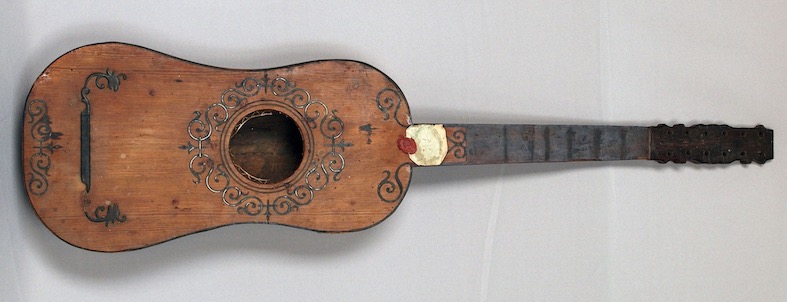Vihuela of Santa Mariana de Jesús
(1625) - Quito, Ecuador. Iglesia de Nuestra Señora de Loreto (de la Compañía de Jesús)
instrument: vihuela de mano | century: 17cent/1/early | catalogue nº: 17-103

Artwork
Creator
Medium Instrument
Location
City Quito | Region Ecuador | Old kingdom America
Characteristics
| Body Waisted | Strings 6 courses | Neck Long | Pegbox Angled flat |
| Bridge Fixed | Frets No | Back Flat | Pegs Rear |
| Technique None |
Commentary
INSTRUMENT
Vihuela, early 17th century (?). Quito, Iglesia de Nuestra Señora de Loreto (de la Compañía de Jesús), belonged to Santa Mariana de Jesús (1618-1645).
6-course vihuela. Built probably early in the seventeenth century in Latin America mixing traditional design elements of Spanish vihuelas of the 16th century with decorative and design elements from Venetian guitars of the early 17th century. Detailed measurements and description in Bordás 1991, 33p. ff) Length 1015 mm; mensur 727mm. The instrument is preserved among the relics of Santa Mariana de Jesús (1618-1645). Gonzalez2012 gives a biographical sketch of the saint and her life. The instrument appears to have been built in the Americas although many features of its style are similar to European guitars of the early 17th century, in both construction and decoration. It’s decoration links it to the guitars made in Venice by Matteo Sellas 17-210. Instruments by him with similar decoration, particularly around the sound hole survive from c.1614-c.1640. The profile of the body design is also remarkably similar.
Attention was first drawn to the instrument by Chilean guitarist and lutenist Oscar Ohlsen in 1976 in an unpublished paper that circulated among enthusiasts. Ohlsen’s drawing is reproduced in paniagua1990, p. 41. Ohlsen’s information was converted into an article by Diana Poulton (poulton1976-1) in The Lute. Access to the instrument has been difficult due to it being in a glass clase with the other relics of Santa Mariana. It was inspected and photographed out of the case by in Gabriel Garrido, and later by Carlos González who appears to be the first maker to have built a replica.
For other similar instruments see
17-101, 17-201, 17-111, 17-210